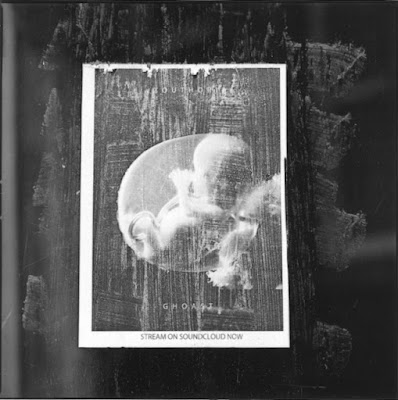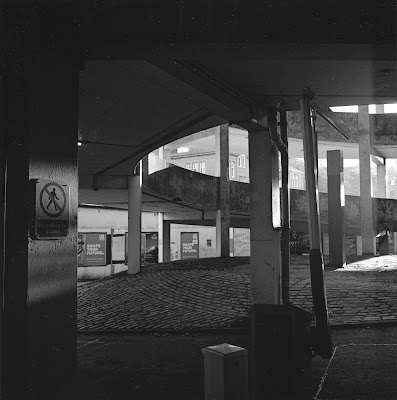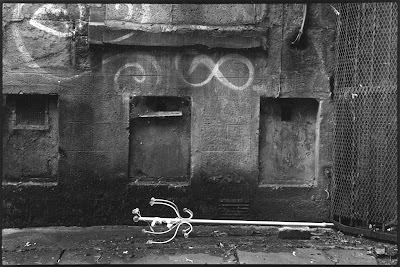Good morning to you - and if you are living through a PVD, my sympathies. Since manifesting itself in June it has become somewhat of a bane. My eyes run the gamut from crystal clear and sharp with blurry bits like the tail-ends of ghosts drifting around, to full-on, low-light blur.
It is very very difficult to take photographs under such conditions - especially with an f4 lens as I was doing here and in low light too - well, more like unbelievable sunshine and deep shadow. But I got there, hence the title of the post.
Let me say this - hyper-focal focusing is a total Godsend!
I can honestly say that this is hardly the most inspiring set of photographs I have ever taken and in reality probably a total waste of a fiver's worth of HP5+, but sometimes you just have to go out and do something.
I've found photography, for me, to encompass:
All consuming times where everything clicks
Non-consuming (but fun) times where nothing really clicks but you enjoy yourself
Load, wind, look and snap - a semi-pointless exercise where nothing works
and
Explore, click, but what is the point?
This was the latter, where you go through the motions, find some places you've not been to, but still take photographs even though you know the end result will be fairly pish.
I've had a deep urge to photograph in heavy undergrowth in recent times, however it isn't always easy to find - or currently to deal with!
I've done The Gulch a few times and only want to go back there when I have got the IR filter thing on the Hasselblads sorted out - a vastly expensive and frustrating exercise.
So for this waste of time, I decided to re-tread my old stomping ground around the back of Duncan Of Jordanstone College Of Art And Design, or DOJCAD as it has been snappily acronymed.
Actually that acronym seems to change on a yearly basis, so I might just stick with Russel T. Hutcheson's wonderful Drunken Disorderly (and yes I know it isn't an acronym).
You know, its funny, I must have dozens and dozens of photographs of this place, but I've probably only printed a handful.
David M (a worthy commenter and reader of FB) commented a few posts back that I always seemed to be taking pictures of barriers (sic); ways blocked; doors; windows; reflections, and that metaphorically I was in a way photographing my own inhibitions.
It set me thinking and I kind of agree with him, however in the case of endlessly rephotographing DOJCA, what I think I am doing is subconsciously documenting my own failure to pursue a path in the creative industries.
I suppose I am desperate to get back in.
Or rather not get back in, but actually get in per se.
OK - mini-rant coming up - take it or leave it:
It's taken me a long time to realise, but deep within, I've an urge to teach people how to use film and how to print the results - I guess I would call it McKenzie Syndrome.
For a small part of my life Joseph McKenzie (go on look him up!) gave me the opportunity to learn a craft skill from which I am still learning - Darkroom Work. I've said it before, but printing in a darkroom is one of the greatest, most frustrating, but ultimately fulfilling parts of photography.
I almost feel that without that ability to print your negatives on proper 'wet' paper (with all the associated smells, the red light, the tactility) you're like a one-legged sprinter.
I know it's probably just me and where I've come from in a craft manner, but to my mind, the two go hand in hand, and no, scanning (yes I know, I do a lot of it) and ink-jetting really is not the same thing.
Rant continued, in which your author goes all misty-eyed and attack puppy all at the same time:
A few weeks back, I spent a couple of hours with the SWC/M, a roll of SFX and a Lee IR filter, carefully composing and taking some cracking (to my blurry eyes) photographs in a IR-stylee.
Thing is, had I been a bit more sussed (coor remember that "You're coming with US, We've got you on SUS" - The Ruts!) I'd have realised and known that the Lee filter is entirely the wrong thing for Ilford SFX because it transmits Nm more suited to 'proper' infrared film, rather than SFX's HP5+ in a splangly mankini (which is what SFX is really).
Consequently when I developed said film I discovered that I had a whole roll of blurry reflections of the SWC/M's filter ring!
Oh how I larfed.
Anyway, that's all an aside, whilst lurking, yes lurking, around the back of the College, I saw a young chap with a camera, totally absorbed in what he was doing, and photographing the same things (sic) that I had been photographing. So I stopped him and started chatting.
He's a Fine Art student, finished his Foundation Course and has put in to study Painting and Photography in Second year.
And of course, the dam burst and I couldn't shut up.
I quized him, advised him, recounted tales of Joe McKenzie, asked him about his camera, showed him mine, found out that the photography department now only has TWO darkrooms, not the [if I remember correctly] SEVEN or EIGHT from my day.
Do you have any film cameras you can borrow?
I asked, because in Joe's day, there was a room stuffed to the gunnels with everything from old Takumar super wides for the ubiquitous K1000s, through to Sinars and their lenses, heading along the way with a mighty collection of Mamiya C330's (wot I learned my MF skills on).
His answer:
"Well, there's a cabinet with some cameras in it, but I am not sure whether you can borrow them."
I couldn't contain my disappointment. Why would you have a few cameras that might not even be for use, when (according to our young snapper and also something I heard from a lecturer in digital animation a few years back) there is a hunger for learning film?
Were it my department, I'd have a bunch of C330's again and also a bunch of Nikon F's (from a reliability stance that takes you from amateur to professional without missing a beat) and I'd be pushing the traditional; because to me, photography isn't just about wishy-washy art speak (and me and the young chap laughed about this); it isn't about re-treading the same poses and the same subject matter.
It's about trying to make it your own.
It really is about the craft of the thing.
Sure you can run and produce really rather top grade looking bits of work - it's relatively easy these days - but without a grounding in tradition, you're missing something.
I don't want to go all huffy on you, but to be honest, what is the point of a photography department or education these days?
Ah, that's stopped you hasn't it.
As we used to sing when young:
Everybody's doing it, doing it, doing it!
Pickin' their nose and chewin' it, chewin' it, chewin' it.
Look around you - you're awash with digital imagery and to a man 98% of it all looks the same.
Even flicking through that august journal BJP, you spot the posed urban portraits (40 years and counting - the same pose!); the fecking awful landscapes; the bog standard fashion photography; still lifes that are as devoid of life as a collection of inanimate objects; street photography (which to my eye is utterly indistinguishable from one continent to another) . . but, and here's the kicker, pick up a BJP from 20 or 30 years ago and it is the virtually the same.
So what has happened to photographic education apart from the fact that it is now mostly called Imaging, and has an armoury of simple tools which produce professional looking results.
Well, I think what is missing is groundwork.
Sure there are some excellent educators out there and it is entirely up to the student where they go. But I dunno, were it to start in a way like, say:
"Here's a knackered old Minolta Autocord TLR - the lens is scratched to infinity, however the wonderful wee Seiko shutter works perfectly. It might feel like an old cardboard box falling apart when you wind on, but you'll get results if you're careful."
then things might be different.
Frustration with semi-adequate tools doesn't half sort out the wheat from the chaff.
So how does that work?
Well simply, if you have a hunger and a drive to do it, because you actually love it rather than are just doing it because you feel you have to . . .
Well . . you're an educated reader, you can put two and two together.
Struggle fosters desire - kicking against the pricks as it were.
You hunger to become better.
Your passion spurs you on.
You try harder.
It's all gone a bit aftershave adverty hasn't it!
But this being said, there's a lot of people out there in positions of influence, responsible for the direction and nurturing of future creative brains, who have got a long way, by producing . . . hmmm, just stuff and (more importantly) talking the talk.
Creativity is (or can be for certain people) an easy and well-paid activity - you just have to be lucky, or else really good - Mr. Joshua Cooper in Glasgow please take a bow - he walks the walk, talks the talk and seems to be one of the few old-school traditionalists still teaching.
Sadly though for some, it sems to have become a monthly pay cheque and a bit of a reputation.
They talk art speak and are accepted and unquestioned - it's all as smooth as a James Bond.
Look up your Port Glasgow colloquialism . . .
As I said to our young photographer (and he actually agreed) - if he really wanted to make it as an artist, all he had to do was approach anything with braggadocio and confidence and speak that speak, and nobody will take you down.
They're too afraid.
Art these days seems to be a world founded on utter bullshit - but then maybe it always was.
If you can glue Polo Mints in the shape of a cross to a bit of painted plywood and bullshit your way to a pass-mark by saying you think it symbolises your Granny giving you Polos to shut you up when she took you to Church, with conviction, then man, the Art World is yours.
That's my experience folks.
There is a point to all this - the sorry and real end for Joseph McKenzie (now called The Father Of Modern Scottish Photography) was that the department he'd built with love and love and love was considered old fashioned and was GUTTED in favour of the oncoming digital tide.
He and I spoke around 1991 and I got the impression that rather than being ignomanimously pushed out, he'd rather jump and so he did, into retirement and subsequent legend.
I wonder what happened to the Takumar Super Wides?
I guess that's why I rail against digital so much - it changed things, rather like having your childhood home bulldozed
Sometimes, progress, and I use the term loosely, isn't necessarily for the better.
I said all this to our (by now probably wondering what the hell was going on) young photographer.
I'm glad he agreed with me.
After assaulting his ears (and recommending some photographers) I bade him farewell and headed for home.
Phew! Sorry about that, I don't half get riled.
IF YOU SKIPPED THE ABOVE, IT'S ALRIGHT NOW, IT'S OVER, YOU CAN SIT DOWN AGAIN.
Camera was a Hasselblad 500C/M, lens a 150mm f4 Sonnar, and I had to use the Leitz Table Top Tripod to give me some bodily bracing.
I would normally detail the contact print here, but to be honest it really isn't worth it - the title of the post says it all - I could barely see a thing.
So here's the prints that I actually thought worth printing . . . should I have bothered?
This delightful little poster was posted on a window and I liked the way UV had aged the paste - fecking weird eh! - no, me that is, not the poster. Anyway, it's my favourite from this session.
It was 1/60th at f5.6.
This is the 'Fine Art' Department. I kind of agree with its epithet though - fines should be applied every now and then.
I made the most of the gorgeous out of focus effects that a Sonnar can produce - it was 1/125th at f5.6.
Ah, our old mate - you know I have photographed and posted so much about this bit of graffiti I am surprised it isn't as famous as a Banksy.
It was a 1/15th at f5.6 - there's bracing for you.
The quote "Prejudice Births Malcontents" appears to come from computer game called Dark Souls and in a weirdly happenstance sort of way, this is what yer WikiP says about it:
Dark Souls is a third-person action role-playing game. A core mechanic of the game is exploration. Players are encouraged by the game to proceed with caution, learn from past mistakes, or find alternative areas to explore.
I shall say no more than that.
Anyway, and finally, your carers are coming soon and I'd better wrap up . . .
Briefly, I had great good fortune to find a box of Agfa MCC Fibre - unopened and cold stored - 5x7" and it was perfect.
It's an early warm-tone paper from the early-mid 90's and is bloody beautiful to use, especially at this image size, which is approximately 4½ x 4½ inches.
I lightly toned them in Selnium and it took the warmth down a tad - lovely.
It might seem daft to have such a capable camera system and then print so small, but they're little jewels of prints and I highly recommend everyone shooting square tries it.
This is a scan of an actual print - yes the border looks squinty-woo, but I've over-emphasised the right edge so you can see the actual edge of the print.
I nearly typed pint there.
Needs must and all that.
 |
| Mine's A Pint . . . Sorry, Print |
Thanks for sticking with it - this was produced under very difficult circumstances for me old beady mincers - I think a visit back to the optician is in order.
Over and oot.
Beam me up Scotsman.



















































